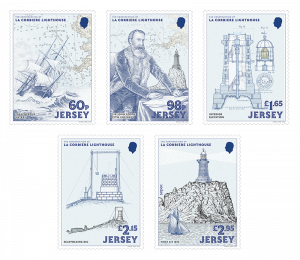
2024 marks 150 years since La Corbière Lighthouse was first lit, providing a guiding light for seafarers around the island shores. To commemorate this occasion and tell the story of its construction, the stamp issue fully entitled ‘SEPAC Iconic Tourist Destination: 150 Years of La Corbière Lighthouse: First Lit 1874’, was issued on 24th April 2024.
The stamp artwork is by Norwegian engraving artist Martin Mörck, whose powerful illustrations are inspired by the original working engineers drawings of the lighthouse. La Corbiere’s lighting was a huge achievement for the Island as the rocky waters around La Corbière were often the roughest part of their journey. The guiding light provided safety and assured sailors that they were entering the final straight towards the harbour of St Helier, better said with the Jèrriais phrase, ‘…j’avons pâssé La Corbiéthe!’ translated as ‘we’ve passed La Corbière,’ the worst is over.
The artwork depicted on the stamps features key moments in the building of the lighthouse:
Treacherous Waters (60p) the Masters of Steamers and Sailing Vessels in 1865 petitioned for the lighthouse to be built by writing to the Piers and Harbour department. They stated a lighthouse was needed due to “fleets being exposed to the greatest dangers in the vicinity of the Island during the night on account of there being no guiding lights”.
Sir John Coode Engineer (98p) was a world-renowned engineer who wrote a document entitled ‘La Corbiere Lighthouse Jersey Specifications’ in March 1873. Within this document, he detailed the specifications of La Corbiere Lighthouse, the causeway and two cottages, where the lighthouse keepers could reside.
Interior Elevation (£1.65) Imrie Bell, the executive engineer for the States of Jersey La Corbière project, detailed the development of the lighthouse in his book ‘Construction of La Corbière Lighthouse and the St Helier’s Harbor’.
Scaffolding Rig (£2.15) The construction of the lighthouse didn’t come without difficulties. Imrie had to both figure out how to commence the foundations of Corbière lighthouse, and how to get the materials from the mainland to the isolated island rock. A scaffolding rig was used to help with this construction and led to the project’s completion.
First Lit 1874 (£2.95) The survey for La Corbière Lighthouse work was completed in 1873, with the masonry of the lighthouse and half-tide causeway finished in November of the same year. Finally, in April 1874, the light was exhibited for its first trial.
The miniature sheet included in the stamp issue features an illustration of the lighthouse seen over the water at high tide with a ship in full sail in the foreground and a glow-in-the-dark UV spot ink over the light beam.
La Corbière Lighthouse has become one of the most photographed landmarks in Jersey and is a popular tourist site, known for its panoramic views, dramatic vistas, and breathtaking sunsets. The lighthouse is today managed and maintained by the Ports of Jersey whose CEO, Matt Thomas, commented: “It’s an honour for Ports of Jersey to be entrusted with the care of one of Jersey’s most iconic landmarks. Corbiere Lighthouse is still used as a navigation aid to this day, marking hazards for seafarers on the south and west coasts, both as a painted day mark and a night-time warning light. We take our responsibility seriously and carry out regular inspections to maintain the critical service the lighthouse performs, and to keep the original brass fixtures and fittings polished. In preparation for this year’s anniversary, the lighthouse has had a fresh coat of paint both inside and out, and we look forward to celebrating this special birthday with Jersey Post’s exclusive issue of celebratory stamps.”
Jersey Post Group CEO, Mark Siviter commented, ”Jersey Post enjoy a close working relationship with the Ports of Jersey, so we are delighted to celebrate the birthday of La Corbière Lighthouse with them. The stamp team has loved researching the story and creating an issue that illustrates the origins of the lighthouse which is much loved by locals and visitors alike.”

 Åland
Åland  Faroe Islands
Faroe Islands  Gibraltar
Gibraltar  Greenland
Greenland  Guernsey
Guernsey  Isle of Man
Isle of Man  Jersey
Jersey  Liechtenstein
Liechtenstein  Luxembourg
Luxembourg  Malta
Malta  Monaco
Monaco  Vatican City
Vatican City 